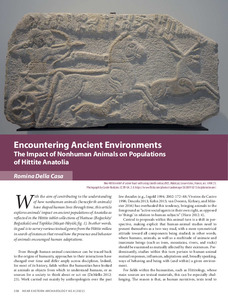Por favor, use este identificador para citar o enlazar este ítem:
https://repositorio.uca.edu.ar/handle/123456789/16434| Título: | Encountering ancient environments : the impact of nonhuman animals on populations of Hittite Anatolia | Autor: | Della Casa, Romina | Palabras clave: | ANIMALES; HISTORIA ANTIGUA; HITITAS; POBLACIONES ANTIGUAS; HUMANIDADES | Fecha de publicación: | 2022 | Editorial: | American Society of Overseas Research | Cita: | Della Casa, R. Encountering ancient environments : the impact of nonhuman animals on populations of hittite Anatolia [en línea]. Near Eastern Archaeology. 2022, 85(49). Disponible en: https://repositorio.uca.edu.ar/handle/123456789/16434 | Resumen: | Resumen: With the aim of contributing to the understanding of how nonhuman animals (henceforth animals) have shaped human lives through time, this article explores animals’ impact on ancient populations of Anatolia as reflected in the Hittite tablet collections of Hattusa (Boğazköy/ Boğazkale) and Tapikka (Maşat-Höyük; fig. 1). In other words, its goal is to survey various textual genres from the Hittite milieu in search of instances that reveal how the presence and behavior of animals encouraged human adaptations. Even though human-animal coexistence can be traced back to the origins of humanity, approaches to their interactions have changed over time and differ amply across disciplines. Indeed, for most of its history, fields within the humanities have looked at animals as objects from which to understand humans, or as sources for a society to think about or act on (DeMello 2012: 23). Work carried out mainly by anthropologists over the past few decades (e.g., Ingold 1994; 2002: 172–88; Viveiros de Castro 1998; Descola 2013; Kohn 2015; van Dooren, Kirksey, and Münster 2016) has overhauled this tendency, bringing animals to the foreground as “active social agents in their own right, as opposed to ‘things’ in relation to human subjects” (Hurn 2012: 4). Central to proposals within this animal turn is a shift in perspective, making explicit that human-animal studies need to present themselves as a two-way road, with a more symmetrical attitude toward all components being studied; in other words, where humans, animals, as well as a multitude of animate and inanimate beings (such as trees, mountains, rivers, and rocks) should be examined as mutually affected by their existences. Predominantly, studies within this turn pertain to human-animal mutual responses, influences, adaptations and, broadly speaking, ways of behaving and being with (and within) a given environment. | URI: | https://repositorio.uca.edu.ar/handle/123456789/16434 | ISSN: | 1094-2076 (impreso) 2325-5404 (online) |
Disciplina: | HISTORIA | Derechos: | Acceso restringido | Fuente: | Near Eastern Archaeology. 2022, 85(49) |
| Aparece en las colecciones: | Artículos |
Ficheros en este ítem:
| Fichero | Descripción | Tamaño | Formato | Login |
|---|---|---|---|---|
| encountering-ancient-environments.pdf | 1,38 MB | Adobe PDF |  SOLICITAR ACCESO |
Visualizaciones de página(s)
83
comprobado en 27-abr-2024
Descarga(s)
30
comprobado en 27-abr-2024
Google ScholarTM
Ver en Google Scholar
Este ítem está sujeto a una Licencia Creative Commons

